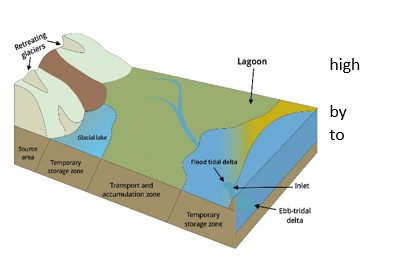

28th July 2025 (17 Topics)
Context
On July 8, 2025, a Glacial Lake Outburst Flood (GLOF) originating in Tibet caused devastation in Nepal, highlighting transboundary vulnerabilities and climate-induced risks in the Himalayas.
Understanding GLOFs and Their Triggers
- What is a GLOF?
- A Glacial Lake Outburst Flood (GLOF) is a sudden release of water from a glacial lake due to dam failure, often leading to catastrophic downstream flooding.
- Types of Glacial Lakes in the Himalayas

-
- Supraglacial Lakes: Formed on glaciers; prone to melting during high summer temperatures.
- Moraine-Dammed Lakes: Blocked by loose sediment or ice; vulnerable to sudden collapse due to structural weakness.
- Major Triggers
- Ice or rock avalanches, Earthquakes, Excessive glacial meltwater pressure, Landslides into glacial lakes etc.
GLOF Impacts in Nepal and the Himalayas
- July 2025 Event
- Washed away a China-built bridge on the Lende River in Nepal
- Damaged four hydroelectric plants, cutting off ~8% of Nepal’s power supply
- Lack of early warning from China cited by Nepalese officials
- Previous GLOF Incidents in Nepal
- Solukhumbu (2024), Mustang (2025), Humla (2025)
- Historical Cases: Cirenma Co (1981), Dig Tsho (1985), Tama Pokhari (1998)
- Demonstrates a repeated pattern of high vulnerability without transboundary alert mechanisms
India’s GLOF Vulnerability
- Geographic Exposure
- 28,000+ glacial lakes in Indian Himalayan Region (IHR)
- Over 7,500 lakes above 4,500m; inaccessible for most of the year
- Risk hotspots: Sikkim, Uttarakhand, Himachal Pradesh, Ladakh, Arunachal Pradesh
- Recent Incidents
- Sikkim (2023): South Lhonak GLOF damaged the $2 billion Chungthang Dam
- Kedarnath (2013): Chorabari lake outburst, compounded by cloudbursts and landslides — caused massive devastation
- Environmental and Infrastructure Risks
- Riverbed siltation (Teesta), dam failures, and displacement of communities
- Increased frequency due to record global temperatures (2023–2024 were hottest years globally)
India’s National Response and Mitigation Strategy
- NDMA & CoDRR Initiatives
- Shift from reactive to proactive disaster risk reduction
- Committee on Disaster Risk Reduction (CoDRR) formulated a national strategy
- Key Features of the National Programme
- $20 million initiative for 195 at-risk glacial lakes
- Risk categorized in four levels
- Five-fold objectives:
- Hazard Assessment
- Automated Weather and Water Stations (AWWS)
- Early Warning Systems (EWS)
- Risk Mitigation (e.g., drawdown channels, retention walls)
- Community Engagement
- Use of Technology
- Synthetic Aperture Radar (SAR) Interferometry: Detects micro-changes in slope stability
- Electrical Resistivity Tomography (ERT): Assesses moraine dam integrity
- UAVs and Bathymetric Surveys: Determine lake volume and topography
- Field Implementation
- Expeditions to 40 high-risk lakes in 2024
- Local communities engaged to ensure cultural and ecological sensitivities are respected
- Monitoring stations in Sikkim providing near real-time lake data every 10 minutes
Challenges Identified
- Lack of Transboundary Early Warning: No formal mechanism with China despite repeated cross-border GLOFs
- Data Deficiency: Inadequate monitoring stations; surveys possible only in brief summer window
- Technological Gaps: Limited indigenous innovation and underutilisation of advanced geospatial tools
- Community Disconnect: Cultural resistance and inadequate awareness among local populations
Way Forward
- Bilateral/Regional Cooperation: Formalise early warning agreements with China, Nepal, and Bhutan through multilateral platforms (e.g., BIMSTEC, SCO)
- Technological Investment: Expand use of SAR, UAVs, EWS and geospatial modelling tools in IHR
- Local Capacity Building: Involve local communities, NGOs, and mountaineering institutions in field surveillance
- Policy Integration: Align glacial risk mapping with national climate adaptation and infrastructure planning
- Cryosphere Research Funding: Support Indian R&D institutions for long-term climate-glacier-disaster research synergy
More Articles

